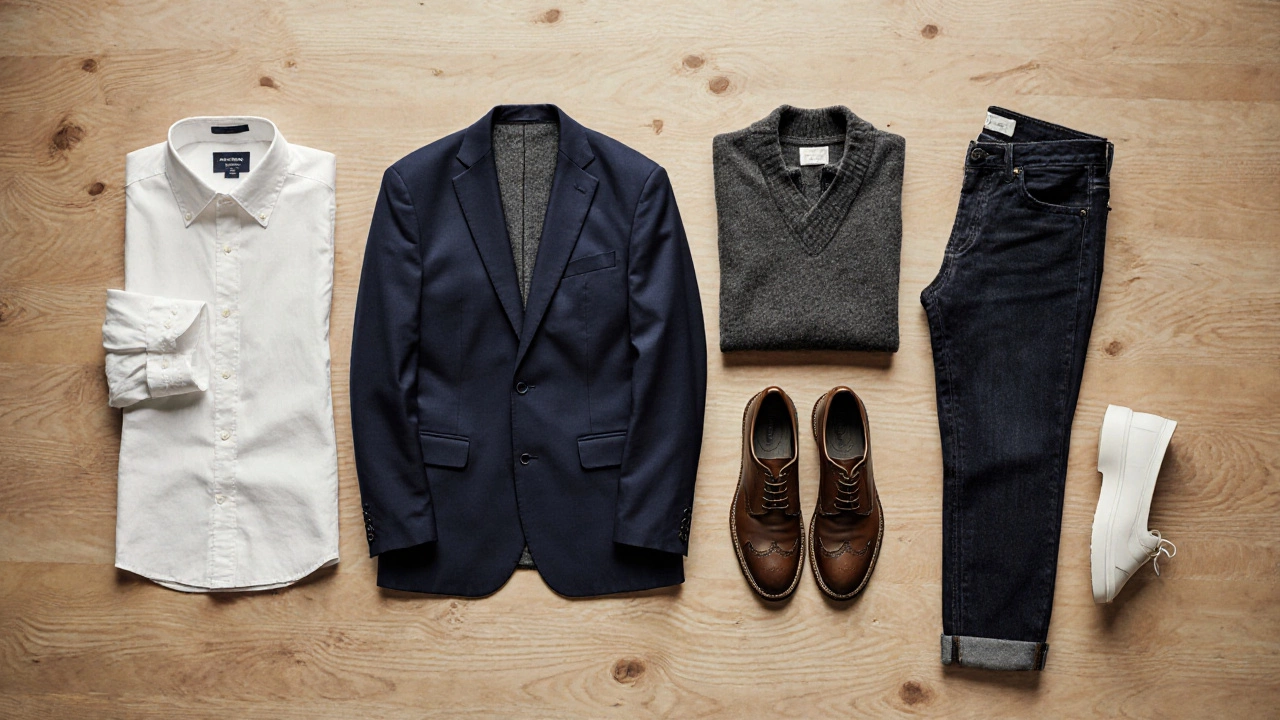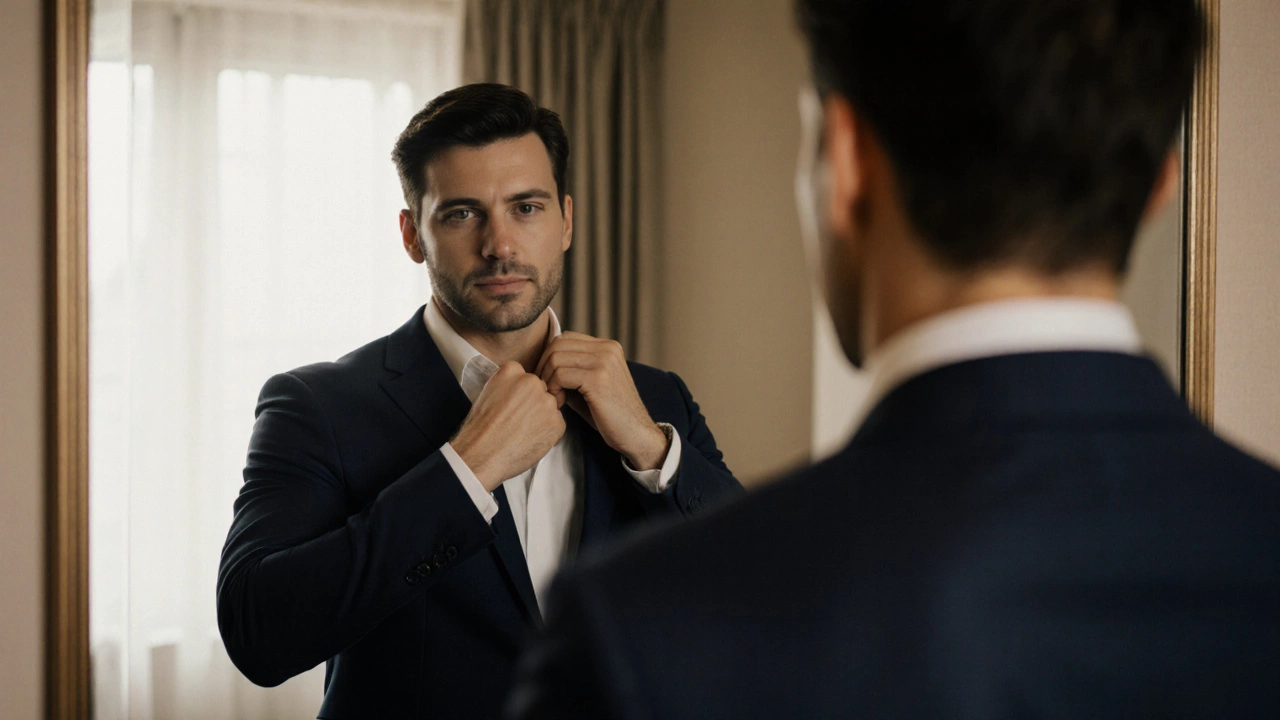Men's Style Wardrobe Planner
Your Personalized Wardrobe Plan
Select your preferences and click "Generate My Wardrobe Plan" to see your personalized style recommendations.
Key Takeaways
- Fit beats trend - the right silhouette makes any garment look intentional.
- Start with a capsule of versatile pieces; build outward.
- Neutral colour palettes create easy mix‑and‑match opportunities.
- Quality footwear and minimal accessories finish the look.
- Consistent grooming ties the whole image together.
When it comes to personal presentation, Men's style is the practice of selecting clothing, accessories, and grooming habits that convey confidence, professionalism, and timeless elegance. It’s the invisible handshake you give the world before you even speak. Below is a step‑by‑step guide that lets you cultivate a look that feels authentic, effortless, and appropriate for any setting.
1. Master the Art of Fit
Fit is the relationship between a garment’s dimensions and the wearer’s body shape, determining how the piece drapes and moves. A well‑fitted shirt or jacket instantly elevates a simple outfit, while an ill‑chosen size looks sloppy regardless of price.
- Shoulders: The seam should line up exactly with the edge of your shoulder bone. No overhang, no gap.
- Sleeve length: When your arms are relaxed, the cuff should end at the wrist bone, exposing a sliver of shirt cuff.
- Torso: For jackets, you should be able to button the top button without feeling constricted, yet the fabric shouldn’t billow.
- Pants: The break at the shoe should be minimal - a slight kiss of fabric keeps the silhouette sharp.
If off‑the‑rack pieces miss the mark, a good tailor can adjust shoulders, sleeves, and hems for a fraction of the cost of buying new.
2. Build a Core Wardrobe
Wardrobe basics are a curated set of versatile, high‑quality garments that serve as the foundation for multiple outfits. Focus on timeless items that never feel dated.
- Classic white dress shirt - crisp, breathable cotton, slim or tailored fit.
- Oxford button‑down - a step down from formal but still polished.
- Charcoal or navy suit - a single‑breasted, two‑button construction.
- Mid‑weight merino sweater - works over shirts or under jackets.
- Dark denim - a straight or slim cut without distressing.
- Leather brogues and clean white sneakers - the two footwear anchors you’ll use most.
By rotating these pieces, you can create business, smart‑casual, and weekend looks without ever feeling under‑dressed.

3. Choose a Cohesive Colour Palette
Colour palette is the selection of hues that harmonize across an outfit, ensuring visual balance and ease of mixing. Neutral tones-navy, charcoal, camel, beige, white, and black-form the backbone of a gentleman’s closet.
Introduce a single accent colour per season (e.g., forest green tie, burgundy pocket square) to keep things interesting without overwhelming the eye.
- Base: Navy blazer, charcoal trousers, white shirt.
- Accent: Olive chinos, rust sweater, burgundy shoes.
- Seasonal switch: Light grey suit in summer, deep brown leather boots in winter.
4. Invest in Quality Footwear
Footwear is the category of shoes and boots that complete an outfit, influencing both aesthetic and posture. A man’s shoes speak louder than any accessory.
- Oxford or Derby: Ideal for formal and business settings; brown or black leather works year‑round.
- Loafers: Slip‑on style perfect for smart‑casual; suede adds texture.
- Sneakers: Minimalist white leather keeps the look refined.
- Maintenance matters - regular polishing and occasional resoling extend life dramatically.
5. Accessorize With Purpose
Accessories are small items such as watches, belts, ties, and pocket squares that add personality and function to an outfit. The key is restraint.
- Watch: Classic mechanical or clean quartz with a leather strap; avoid overly large faces.
- Belt: Match leather colour to shoes; keep width proportional to trouser loops.
- Tie: For business, choose silk with a subtle pattern; knot should be snug.
- Pocket square: A splash of colour or pattern, folded simply, adds a dash of flair.
6. Grooming - The Silent Partner
Grooming is the routine of facial hair care, skincare, and personal hygiene that complements one’s outward appearance. Consistency here reinforces the polish of your clothing choices.
- Facial hair - keep beards trimmed and neckline clean; a classic short beard works for most face shapes.
- Skin - moisturise daily; a light sunscreen protects against premature ageing.
- Haircut - opt for a timeless style (short back and sides, textured top) that grows out gracefully.
- Nails - trimmed and clean; avoid overly long or bitten nails.

7. Layering and Fabric Selection
Fabric refers to the material composition of garments, influencing comfort, drape, and durability. Understanding fabric guides smart layering.
- Wool - excellent for suits and overcoats; breathes while retaining warmth.
- Cotton - versatile for shirts, chinos, and lightweight jackets.
- Linen - ideal for summer; pair with a lightweight blazer to avoid bulk.
- Cashmere - adds luxury; a thin crewneck works under a coat without overheating.
Layer by weight: shirt → lightweight sweater → structured blazer → overcoat. This order keeps silhouette clean and allows easy removal.
Dress Code Comparison
| Level | Typical Pieces | Footwear | Accessories |
|---|---|---|---|
| Casual | Dark denim, plain tees, casual button‑down | White leather sneakers, desert boots | Leather belt, minimal watch |
| Smart Casual | Chinos, sport coat, knit polo, Oxford shirt | Loafers or crisp brogues | Folded pocket square, leather strap watch |
| Formal | Tailored suit, dress shirt, silk tie | Oxford shoes, polished black leather | Tie clip, cufflinks, classic watch |
Putting It All Together
Start by assessing your current closet. Keep anything that fits well, is in a neutral colour, and feels comfortable. Donate or sell pieces that are out of style, ill‑fitting, or worn beyond repair. Replace the gaps with the core items listed above, prioritising quality over quantity.
Every morning, ask yourself three quick questions: Does this outfit fit? Does it match my colour palette? Does it convey the level of formality required? If the answer is yes, you’re ready to step out with confidence.
Frequently Asked Questions
How often should I replace a suit?
A well‑maintained suit can last 7‑10 years. Replace it when the fabric shows wear, the fit no longer suits your body, or style trends have shifted significantly.
Can I wear sneakers with a suit?
Yes, but choose a minimalist, low‑profile leather sneaker in white or neutral tones, and reserve this look for creative or semi‑formal settings.
What is the best way to care for leather shoes?
Clean them with a soft brush, apply a quality leather conditioner monthly, and store with shoe trees to maintain shape. Polish before each major event.
How many ties do I really need?
A core collection of 5-7 ties-three solid, two patterned, and two seasonal-covers most business and formal occasions without clutter.
Should I match my belt and watch strap?
Matching the belt to shoe colour is essential; extending that harmony to the watch strap adds a subtle, cohesive finish, especially in formal settings.
Mastering men's style isn’t a sprint; it’s an ongoing refinement. By focusing on fit, building a solid basics collection, curating a neutral palette, and paying attention to grooming, you create a timeless image that adapts to any role you assume. The result? A confident, composed presence that commands respect without shouting.

